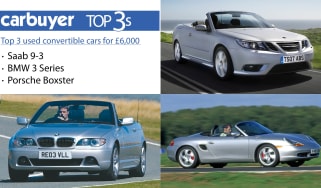Saab 9-3 saloon (2002-2011)
“The Saab 9-3 saloon makes for a quirky alternative to the usual used compact executive saloons.”
Pros
- Cosseting ride
- Generous equipment
- Cheap to buy on used market
Cons
- Saab is no longer in business
- Difficult to source parts
- Tricky to maintain
Saab’s demise has made the 2002-2011 Saab 9-3 a tempting used-car bargain. It represents a different and slightly left-field choice compared to executive cars of a similar age, like the BMW 3 Series, Mercedes C-Class and Audi A4. It rides nicely and should prove pretty cheap to run. Unfortunately, however, the interior doesn’t feel quite up to the mark and the fact that Saab no longer exists might make it tricky to source parts and maintain the car – especially in the long term.
MPG, running costs & CO2
The 1.9-litre four-cylinder diesel engine will cost just as much to run whichever power output you go for, so you might as well plump for the most powerful version. It’ll return 62.8mpg and CO2 emissions of 119g/km means you’ll only have to pay £30 a year in road tax.
Petrol versions aren’t quite so cheap to run, but they’re likely to cost less to buy on the used market. The cheapest of the lot to run is the turbocharged 1.8-litre, which has claimed fuel economy of 39.8mpg and CO2 emissions of 164g/km. This means you’ll have to pay £180 a year in road tax.
Engines, drive & performance
When it comes to engines, there’s plenty of choice. The three diesels are all 1.9-litres, producing 128, 158 and 178bhp respectively. They’re all strong performers, but the most powerful version is properly quick. Similarly, the petrols are all turbocharged and the most powerful – the 207bhp Aero model – will complete the 0-62mph sprint in just 7.3 seconds.
Unfortunately, despite the 9-3’s decent performance, it’s not quite so impressive in corners – especially when compared to its rival the BMW 3 Series. There’s plenty of grip, but it’s never particularly good fun and the steering lacks any sort of feedback.
Interior & comfort
Long-distance drives won’t be a problem in the 9-3. Its seats are supremely comfortable and the ride is as supple as you like, meaning it’s always a comfortable cruiser. The engines are mostly pretty quiet and refined, although the diesels can sound a little harsh, especially under hard acceleration.
Unfortunately, however, the rest of the interior isn’t that great. Even by the standards of its peers when it was new, the Saab’s dashboard felt dated and cheap, an impression that’s been amplified by the passage of time since then.
Practicality & boot space
While the 9-3 never especially shined in terms of practicality, it wasn’t the car’s weakest point, either. Passengers in both the front and rear are reasonably well catered for – the high roofline gives those in the back plenty of headroom – while the boot is a good size. You can go for a 9-3 SportWagon estate if you really need extra space.
Reliability & safety
While Saab in general had a pretty good reputation for reliability, the 9-3 of this particular vintage could never quite live up to that. It shared its mechanical (and electrical) components with the contemporary Vauxhall Vectra, so it suffered similar problems, too.
The Carbuyer owner reviews for this model highlight electrics as the biggest area of concern, while you should make sure the engine is in good nick, too, as those can go wrong. These cars are getting quite old now and so there are always going to be issues.
In terms of safety, the 9-3 is pretty impressive. Saab has a good record and the car’s five-star Euro NCAP score reflects this. It’s important to remember, however, that the score was recorded before 2009, when the testing wasn’t quite so stringent as it is now.
Price, value for money & options
You won’t be wanting for equipment if you go for a used 9-3. Most come with alloy wheels, leather seats, air-conditioning, parking sensors and sat nav. A good example will set you back around £4,000, which is pretty reasonable for what is a fairly handsome and not especially common executive car.












